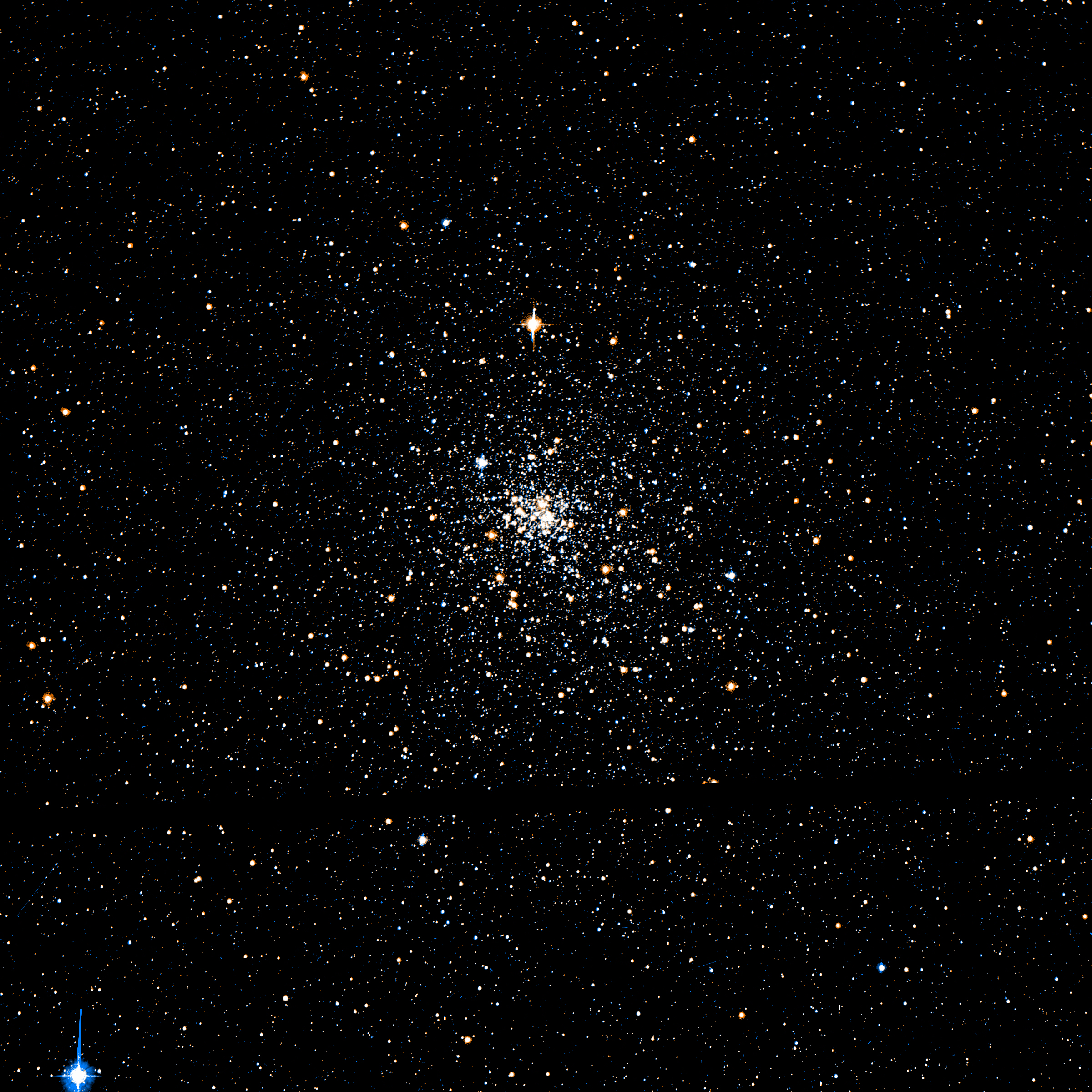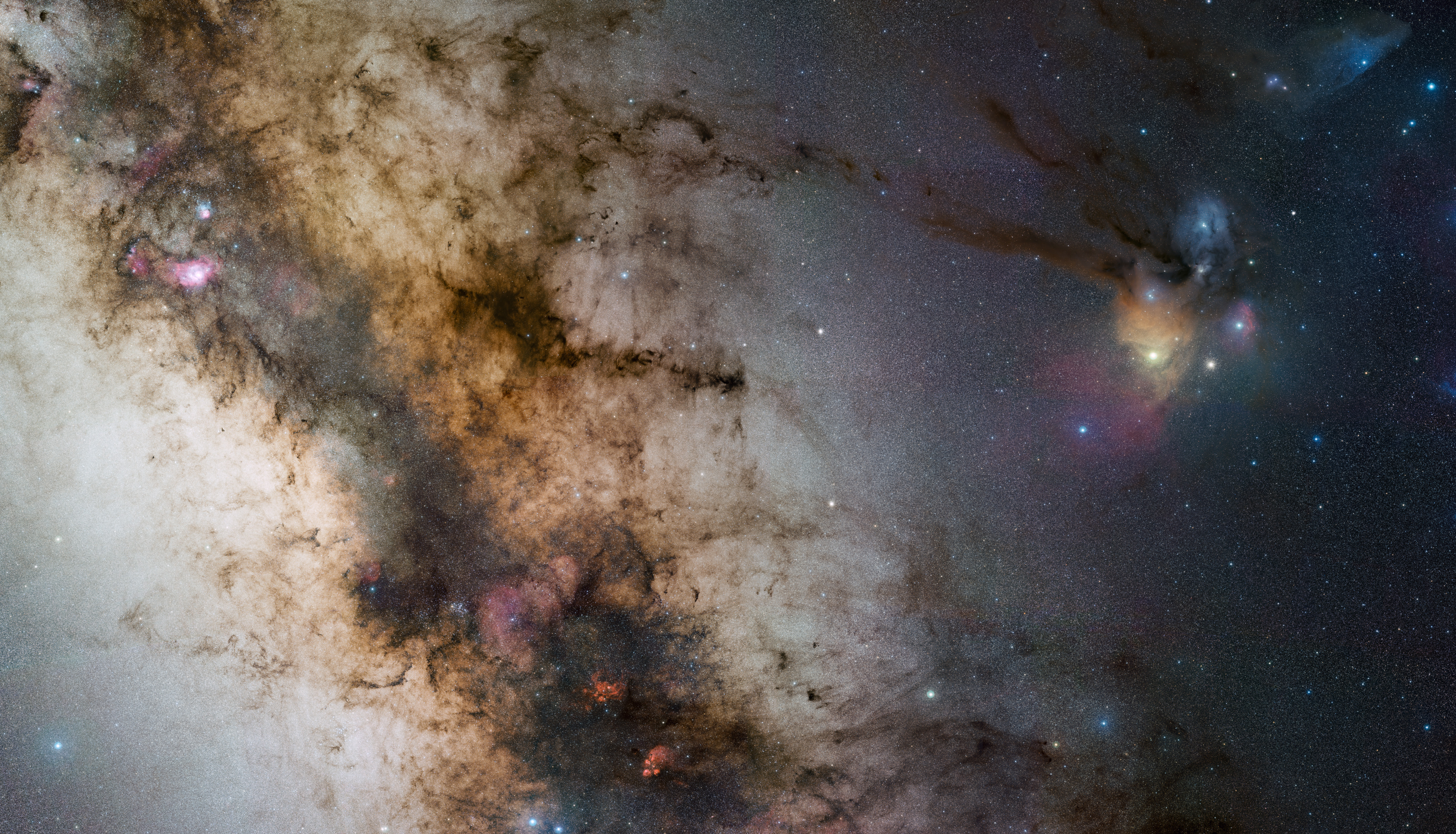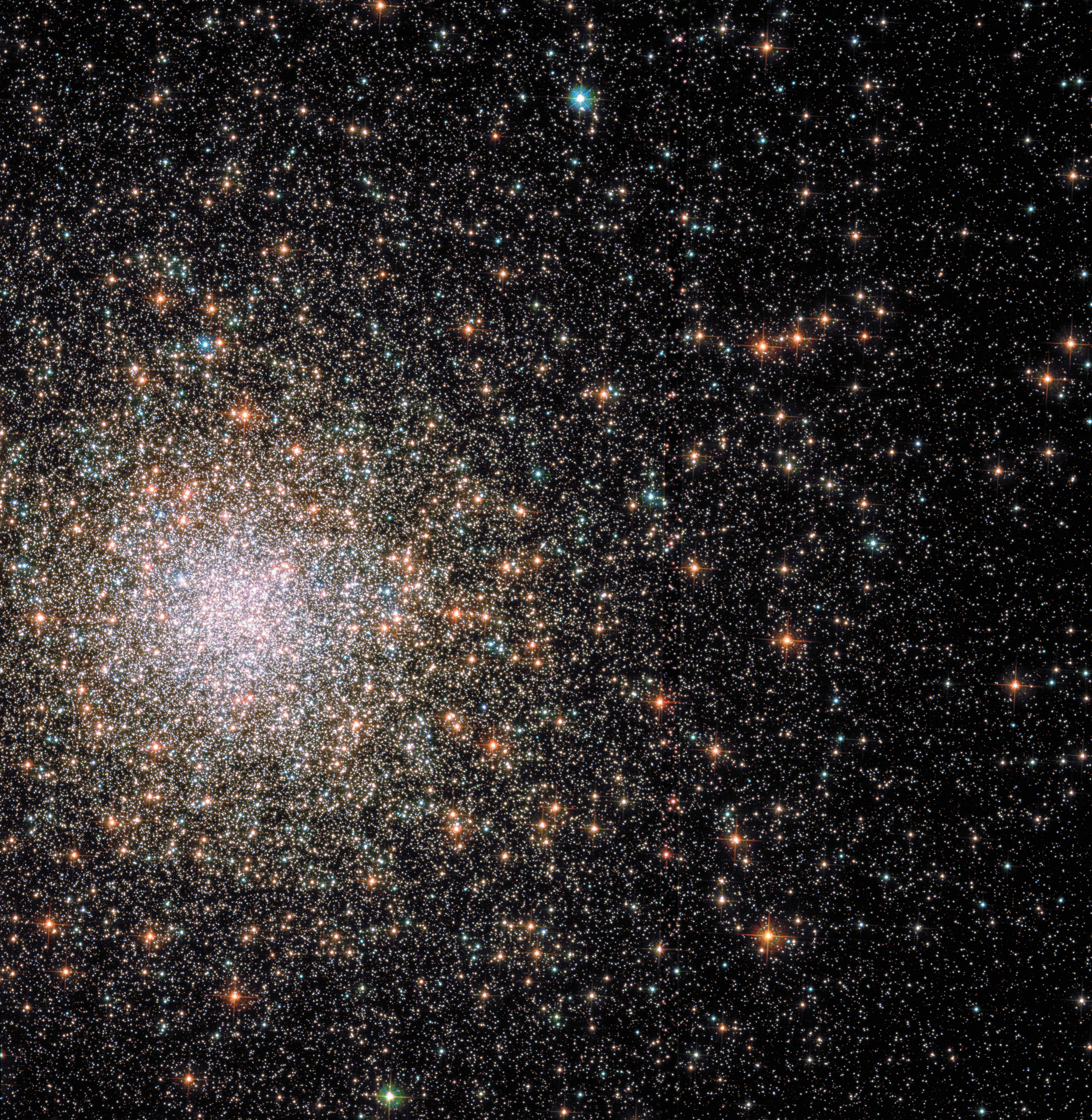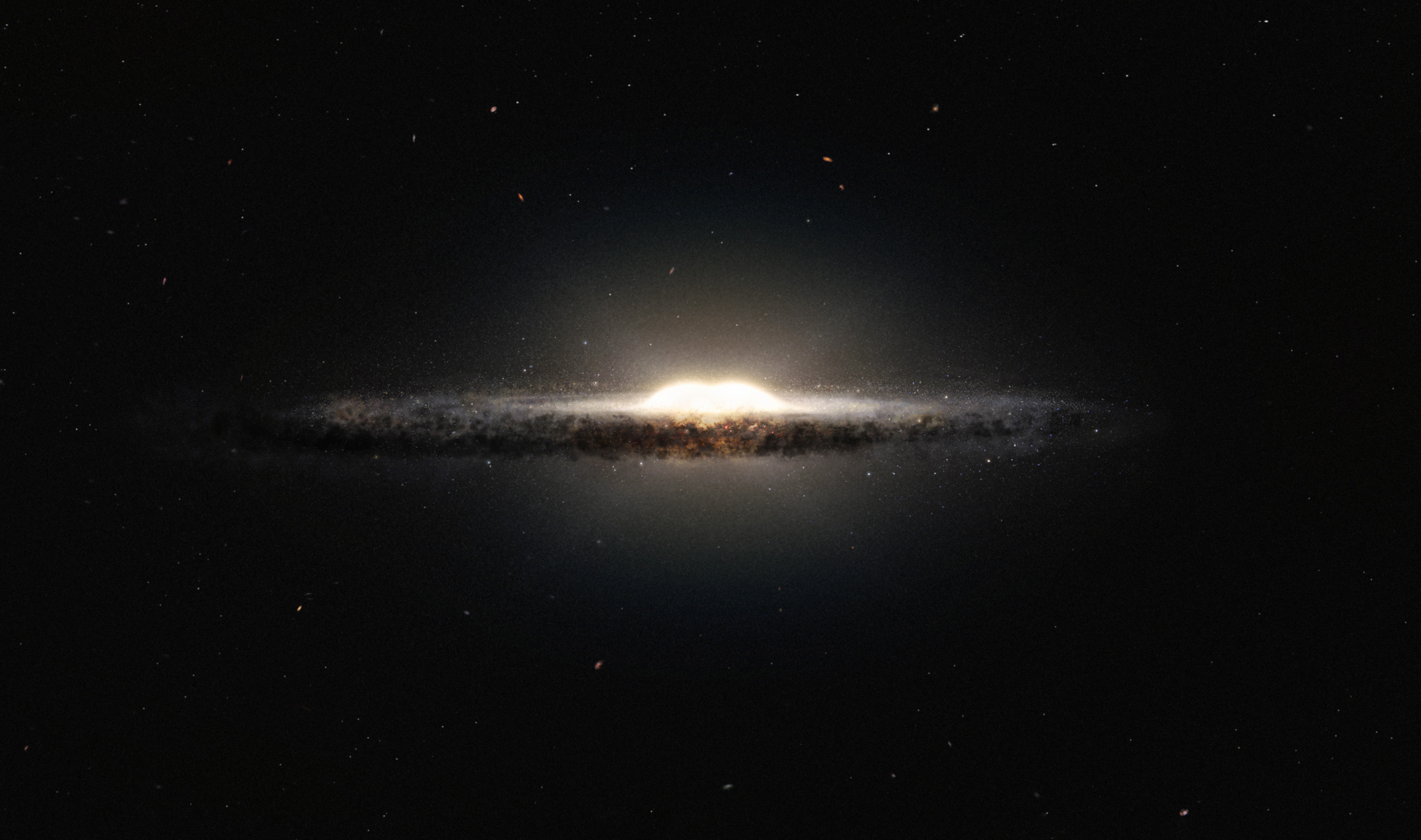|
Palomar 6
Palomar 6 is a loose globular cluster in the constellation Ophiuchus that belongs to the Milky Way galaxy. It is a member of the Palomar Globular Clusters group. It is located about 25,000 light-years (7,700 parsecs) away from the Sun. It formed in what would become the bulge of the Milky Way. It is similar to other old-bulge globular clusters such as Messier 62, NGC 6522, NGC 6558, and Haute-Provence 1. First discovered on the National Geographic Society – Palomar Observatory Sky Survey plates by Robert G. Harrington and Fritz Zwicky, it was catalogued as a globular cluster, and is one of four globulars known to contain a planetary nebula. References External links * Simbad reference data* * Palomar 06 Ophiuchus • In typography, a bullet or bullet point, , is a typographical symbol or glyph used to introduce items in a list. For example: *Point 1 *Point 2 *Point 3 The bullet symbol may take any of a variety of shapes, such as circular, square, ... [...More Info...] [...Related Items...] OR: [Wikipedia] [Google] [Baidu] |
J2000
In astronomy, an epoch or reference epoch is a moment in time used as a reference point for some time-varying astronomical quantity. It is useful for the celestial coordinates or orbital elements of a celestial body, as they are subject to perturbations and vary with time. These time-varying astronomical quantities might include, for example, the mean longitude or mean anomaly of a body, the node of its orbit relative to a reference plane, the direction of the apogee or aphelion of its orbit, or the size of the major axis of its orbit. The main use of astronomical quantities specified in this way is to calculate other relevant parameters of motion, in order to predict future positions and velocities. The applied tools of the disciplines of celestial mechanics or its subfield orbital mechanics (for predicting orbital paths and positions for bodies in motion under the gravitational effects of other bodies) can be used to generate an ephemeris, a table of values giving the positions ... [...More Info...] [...Related Items...] OR: [Wikipedia] [Google] [Baidu] |
NGC 6558
NGC 6558 is a globular cluster, located about 24,000 light years away in the constellation Sagittarius. Its apparent magnitude is about 11 and its apparent diameter is about 10 arcminutes. The globular cluster was discovered in 1784 by the astronomer William Herschel Frederick William Herschel (; german: Friedrich Wilhelm Herschel; 15 November 1738 – 25 August 1822) was a German-born British astronomer and composer. He frequently collaborated with his younger sister and fellow astronomer Carolin ... with his 18.7-inch telescope and the discovery was later catalogued in the New General Catalogue. It is located 1.5 degrees south-southeast of Gamma2 Sagittarii. References External links * NGC 6558 Globular clusters Sagittarius (constellation) 6558 {{star-cluster-stub ... [...More Info...] [...Related Items...] OR: [Wikipedia] [Google] [Baidu] |
Globular Clusters
A globular cluster is a spheroidal conglomeration of stars. Globular clusters are bound together by gravity, with a higher concentration of stars towards their centers. They can contain anywhere from tens of thousands to many millions of member stars. Their name is derived from Latin (small sphere). Globular clusters are occasionally known simply as "globulars". Although one globular cluster, Omega Centauri, was observed in antiquity and long thought to be a star, recognition of the clusters' true nature came with the advent of telescopes in the 17th century. In early telescopic observations globular clusters appeared as fuzzy blobs, leading French astronomer Charles Messier to include many of them in his catalog of astronomical objects that he thought could be mistaken for comets. Using larger telescopes, 18th-century astronomers recognized that globular clusters are groups of many individual stars. Early in the 20th century the distribution of globular clusters in the sky ... [...More Info...] [...Related Items...] OR: [Wikipedia] [Google] [Baidu] |
Planetary Nebula
A planetary nebula (PN, plural PNe) is a type of emission nebula consisting of an expanding, glowing shell of ionized gas ejected from red giant stars late in their lives. The term "planetary nebula" is a misnomer because they are unrelated to planets. The term originates from the planet-like round shape of these nebulae observed by astronomers through early telescopes. The first usage may have occurred during the 1780s with the English astronomer William Herschel who described these nebulae as resembling planets; however, as early as January 1779, the French astronomer Antoine Darquier de Pellepoix described in his observations of the Ring Nebula, "very dim but perfectly outlined; it is as large as Jupiter and resembles a fading planet". Though the modern interpretation is different, the old term is still used. All planetary nebulae form at the end of the life of a star of intermediate mass, about 1-8 solar masses. It is expected that the Sun will form a planetary nebu ... [...More Info...] [...Related Items...] OR: [Wikipedia] [Google] [Baidu] |
Fritz Zwicky
Fritz Zwicky (; ; February 14, 1898 – February 8, 1974) was a Swiss astronomer. He worked most of his life at the California Institute of Technology in the United States of America, where he made many important contributions in theoretical and observational astronomy. In 1933, Zwicky was the first to use the virial theorem to infer the existence of unseen dark matter, describing it as "'". From p 125: ''"Um, wie beobachtet, einen mittleren Dopplereffekt von 1000 km/sek oder mehr zu erhalten, müsste also die mittlere Dichte im Comasystem mindestens 400 mal grösser sein als die auf Grund von Beobachtungen an leuchtender Materie abgeleitete. Falls sich dies bewahrheiten sollte, würde sich also das überraschende Resultat ergeben, dass dunkle Materie in sehr viel grösserer Dichte vorhanden ist als leuchtende Materie."'' (In order to obtain an average Doppler effect of 1000 km/s or more, as observed, the average density in the Coma system would thus have to be at least 400 time ... [...More Info...] [...Related Items...] OR: [Wikipedia] [Google] [Baidu] |
Robert George Harrington
Robert George Harrington (December 3, 1904 – June 15, 1987) was an American astronomer who worked at Palomar Observatory. He should not be confused with Robert Sutton Harrington, who was also an astronomer, but was born later and worked at the US Naval Observatory. He discovered or co-discovered a number of comets, including periodic comets 43P/Wolf–Harrington, 51P/Harrington (discovered in 1953), 52P/Harrington–Abell (discovered jointly with George Ogden Abell in 1955) and the comet/asteroid 107P/Wilson–Harrington, which he and Albert Wilson discovered in 1949 and which had become an asteroid by 1988. Google Books Harrington discovered the dwarf galaxy Leo II and co-discovered the globular cluster Palomar 12 with Fritz Zwicky. The asteroid 3216 Harrington was not named after Robert George Harrington, but rather after Robert Sutton Harrington. Harrington's name is, however, associated with the asteroid/comet 107P/Wilson–Harrington 1 (one, unit, un ... [...More Info...] [...Related Items...] OR: [Wikipedia] [Google] [Baidu] |
National Geographic Society – Palomar Observatory Sky Survey
The National Geographic Society – Palomar Observatory Sky Survey (NGS-POSS, or just POSS, also POSS I) was a major astronomical survey, that took almost 2,000 photographic plates of the night sky. It was conducted at Palomar Observatory, California, United States, and completed by the end of 1958. Observations The photographs were taken with the Samuel Oschin telescope at Palomar Observatory, and the astronomical survey was funded by a grant from the National Geographic Society to the California Institute of Technology. Among the primary minds behind the project were Edwin Hubble, Milton L. Humason, Walter Baade, Ira Sprague Bowen and Rudolph Minkowski. The first photographic plate was exposed on November 11, 1949. 99% of the plates were taken by June 20, 1956, but the final 1% was not completed until December 10, 1958. The survey utilized square photographic plates, covering about 6 ° of sky per side (approximately 36 square degrees per plate). Each region of the sky was ph ... [...More Info...] [...Related Items...] OR: [Wikipedia] [Google] [Baidu] |
Haute-Provence 1
Provence (, , , , ; oc, Provença or ''Prouvènço'' , ) is a geographical region and historical province of southeastern France, which extends from the left bank of the lower Rhône to the west to the Italian border to the east; it is bordered by the Mediterranean Sea to the south. It largely corresponds with the modern administrative region of Provence-Alpes-Côte d'Azur and includes the departments of Var, Bouches-du-Rhône, Alpes-de-Haute-Provence, as well as parts of Alpes-Maritimes and Vaucluse.''Le Petit Robert, Dictionnaire Universel des Noms Propres'' (1988). The largest city of the region and its modern-day capital is Marseille. The Romans made the region the first Roman province beyond the Alps and called it ''Provincia Romana'', which evolved into the present name. Until 1481 it was ruled by the Counts of Provence from their capital in Aix-en-Provence, then became a province of the Kings of France. While it has been part of France for more than 500 years, it st ... [...More Info...] [...Related Items...] OR: [Wikipedia] [Google] [Baidu] |
NGC 6522
NGC 6522 is a globular cluster in the constellation Sagittarius. It is apparent magnitude 8.3, and diameter 16.4 arc minutes, and class VI with stars 16th magnitude and dimmer. It was discovered by William Herschel on June 24, 1784. It is centered in a region of the sky known as Baade's Window. NGC 6522 is possibly the oldest star cluster in the Milky Way, with an age of more than 12 billion years. '''' by David Shiga, 30 April 2011, p. 20 [...More Info...] [...Related Items...] OR: [Wikipedia] [Google] [Baidu] |
Ophiuchus
Ophiuchus () is a large constellation straddling the celestial equator. Its name comes from the Ancient Greek (), meaning "serpent-bearer", and it is commonly represented as a man grasping a snake. The serpent is represented by the constellation Serpens. Ophiuchus was one of the 48 constellations listed by the 2nd-century astronomer Ptolemy, and it remains one of the 88 modern constellations. An old alternative name for the constellation was Serpentarius (). Location Ophiuchus lies between Aquila, Serpens, Scorpius, Sagittarius, and Hercules, northwest of the center of the Milky Way. The southern part lies between Scorpius to the west and Sagittarius to the east. In the northern hemisphere, it is best visible in summer. It is opposite of Orion. Ophiuchus is depicted as a man grasping a serpent; the interposition of his body divides the snake constellation Serpens into two parts, Serpens Caput and Serpens Cauda. Ophiuchus straddles the equator with the maj ... [...More Info...] [...Related Items...] OR: [Wikipedia] [Google] [Baidu] |
Messier 62
Messier 62 or M62, also known as NGC 6266, is a globular cluster of stars in the south of the equatorial constellation of Ophiuchus. It was discovered in 1771 by Charles Messier, then added to his catalogue eight years later. M62 is about from Earth and from the Galactic Center. It is among the ten most massive and luminous globular clusters in the Milky Way, showing an integrated absolute magnitude of −9.18. It has an estimated mass of and a mass-to-light ratio of in the core visible light band, the V band. It has a projected ellipticity of 0.01, meaning it is essentially spherical. The density profile of its member stars suggests it has not yet undergone core collapse. It has a core radius of , a half-mass radius of , and a half-light radius of . The stellar density at the core is per cubic parsec. It has a tidal radius of . The cluster shows at least two distinct populations of stars, which most likely represent two separate episodes of star formation. Of the main ... [...More Info...] [...Related Items...] OR: [Wikipedia] [Google] [Baidu] |
Galactic Bulge
In astronomy, a galactic bulge (or simply bulge) is a tightly packed group of stars within a larger star formation. The term almost exclusively refers to the central group of stars found in most spiral galaxies (see galactic spheroid). Bulges were historically thought to be elliptical galaxies that happened to have a disk of stars around them, but high-resolution images using the Hubble Space Telescope have revealed that many bulges lie at the heart of a spiral galaxy. It is now thought that there are at least two types of bulges: bulges that are like ellipticals and bulges that are like spiral galaxies. Classical bulges Bulges that have properties similar to those of elliptical galaxies are often called "classical bulges" due to their similarity to the historic view of bulges. These bulges are composed primarily of stars that are older, Population II stars, and hence have a reddish hue (see stellar evolution). These stars are also in orbits that are essentially random ... [...More Info...] [...Related Items...] OR: [Wikipedia] [Google] [Baidu] |





